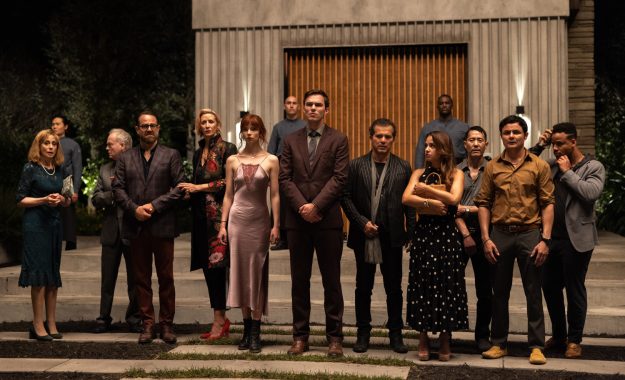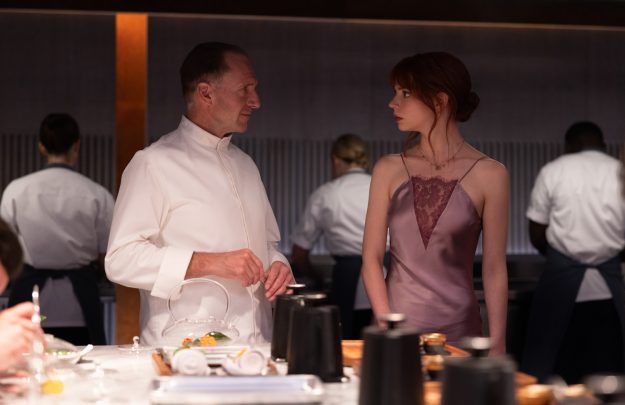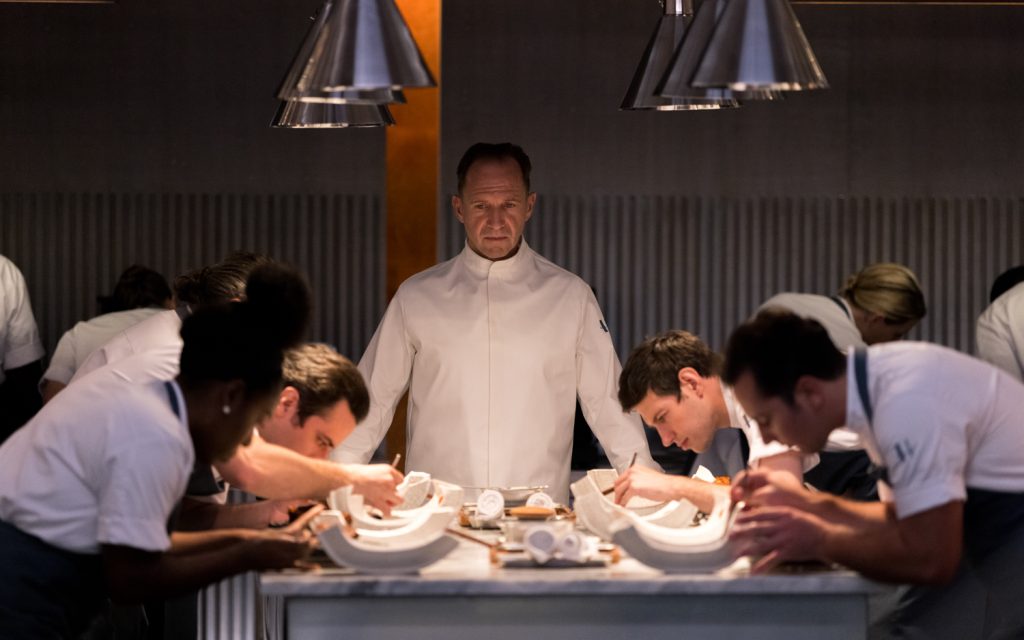Each evening a crisply attired maître d’ welcomes a small group of people to a wooded island as they disembark from a ferry that has brought them from the mainland. This is an island that has been terraformed into a destination restaurant. Ushering them along the shore with a steely hauteur, the maître d’ (Elsa, played by a marvelous Hong Chau) explains with pride how all the ingredients of the evening’s meal will have been harvested from the island’s delicate natural systems—the tide pools, the forests, the gardens, and the fields. What then surfaces is a bitter mélange of systemic violence, both visible and invisible. The Menu, directed by Mark Mylod, provides Buddhist viewers with a way to reflect on the three poisons in their systemic form, and on the ecological implications of dharma as a vehicle for transformation that integrates the personal and the social.
What unfolds is a grand guignol indictment of contemporary grind-work culture with an ethical slant relevant not just to a 20th-century Christian moral framework, but to contemporary Buddhism as well. Moving inland, the steely Elsa guides the diners through the kitchen staff’s Spartan living quarters—two rows of beds, as straight and spare as a military barracks. Hawthorne is not just a restaurant, she explains, it is a family. So far we have been keeping company with Hawthorne fanboy Tyler (Nicholas Hoult) along with his date Margot (Anya Taylor-Joy), whose name Elsa does not find on the evening’s reservation list. This discordant note points toward the horror-movie genre, linking Margot to the final girl, the one left standing at the end, the one who survives. As it turns out, the horror in The Menu is one we all are more familiar with than we might wish—how the high-end luxury market of our new Gilded Age is often fueled by extravagant suffering.

Once they are seated and chatting amiably, we are introduced to the evening’s guests: a pretentious restaurant reviewer with her sycophantic companion, a trio of shark-like finance bros looking for any opening to throw their weight around, an older wealthy couple masking their genteel rage at each other with a pleasant smile, and an over-the-hill action movie star (memorably played by John Leguizamo) who has sold his soul to commerce, dining tonight with his young assistant and lover. Finally, Chef Julian Slowik, the Prospero of this Fantasy Island, appears. Drifting ghost-like through the kitchen in his white coat, he calls his guests to attention with a thunderous clap. Played with a haunted reserve by Ralph Fiennes, Slowik has designed the evening’s menu as a single culinary narrative—a hallmark that sets Hawthorne apart from all the other Michelin destinations around the globe.
Beginning with the amuse-bouche, each course is announced with one of Slowik’s deafening claps, along with a brief statement explaining how it fits into the evening’s menu. The dozen members of Hawthorne’s kitchen staff labor to make each presentation Zen-elegant, echoing the spare compositions cinematographer Peter Deming used earlier to frame the island’s landscapes. And yet Mylod does not go overboard lampooning the preciousness of restaurant culture, offering just enough foodie porn so that our mirror neurons respond when one of the guests finally samples the fare.
Initially, at least, the film instead emphasizes the spiritual dimension of food. He tells the guests that they are “eating the island itself.” “Taste,” Slowik instructs, “savor… be mindful.” Explaining his adulation to the skeptical Margot, Tyler states that chefs are more worthy of worship than movie stars or musicians because “they play with the ingredients of life itself,” and work “at the edge of the abyss, where God works too.”
Tyler’s obsequiousness is appalling to Margot. “You are paying him to serve you,” she points out, drawing the reality of the power relationships at Hawthorne into the light. As if taking its cue from her, the spiritual aura Slowik has conjured begins to dissipate with the menu’s second course. Bread has always been the food of the poor, he explains, and so tonight, since Hawthorne’s guests are not poor, they will get no bread. The diners are scandalized and titillated as the servers distribute elegant platters of condiments sans the bread itself. Food as a history of class, we are told, is among Slowik’s favorite themes.
The only one who sees through the odd gesture of the breadless bread course is Margot, and it is here that she and Slowik first cross swords. When he demands to know why she is not eating, she sensibly replies that she is perfectly capable of deciding when it is time to eat.

Dejected, Slowik retreats to a table in the corner where an older woman sits alone, drinking. When Slowik next introduces the menu’s third course, we learn that this woman is his mother and that she is, indeed, an alcoholic. One night when he was a boy, Slowik explains, his enraged, drunken father tried to strangle his mother with a telephone cord. Slowik saved her by stabbing him in the thigh with a pair of kitchen scissors—and this memorable event is commemorated in the barbecued chicken thighs served up next! Each serving is brought to the tables with the chicken thigh impaled by a pair of tiny scissors. The chicken, it turns out, is part of Slowik’s trademark taco dish, for which the guests have been issued tortillas laser-printed with images pointing toward crimes they have committed. Examining a tortilla embossed with incriminating accounting data, one of the finance bros laments “a taco that could hold up in court.”
Despite the familiar way in which we discover that this seemingly random collection of strangers is not so random after all, and that Slowik is there to enact justice for their sins, The Menu continues to deliver its surprises with droll confidence. “All a part of the menu,” is the refrain Slowik uses to calm his guests as the evening darkens. The casting pays off here, as Fiennes portrays the chef as a man who has already died and is just waiting for the news to finally register.
Chef Slowik adheres to the philosophy of serving his customer, quite literally it turns out, and he has planned this evening’s menu to be his final masterpiece and swan song. “You represent the ruin of my art and my life,” he tells his guests with a taut, genial smile. The deep pain in Slowik’s eyes speaks to us—having met his mother we understand how childhood trauma has left him defenseless against the service economy’s predatory imperatives.
Violence comes first in The Menu, but the film’s real taboo is this element of class conflict. Confronting Margot in the women’s room where she has gone to sneak a cigarette, Slowik bemoans his life of unrelenting pressure. Slowik’s misguided devotion to “pleasing people he will never know” has elevated Hawthorne to a price point where he now only feeds those who, like hungry ghosts, can never be satisfied. We sense here a systemic dimension of Slowik’s woundedness—he is a victim, finally, of the consumer economy. Margot too, it turns out, is a refugee from the implacable economic imperatives producing the luxury and excess on display at Hawthorne. Like Slowik and his staff, she is a “shit shoveler,” a service industry worker who knows what it is like to have to serve bad customers.
A capacity to shine a light on the dynamics of wealth has been creeping back into popular entertainment recently after being banished for several decades. Mylod is a veteran of the acerbic series Succession, for example, and in The Menu he again leavens the sociopolitical critique with humor. How, The Menu asks, are we being harmed by our passive complicity with social and economic systems that enact violence on others and on the planet itself? The film’s early evocation of the link between the alimentary and the ecological returns now to underscore our complicity in the harms that system causes.
Thank you for subscribing to Tricycle! As a nonprofit, we depend on readers like you to keep Buddhist teachings and practices widely available.
